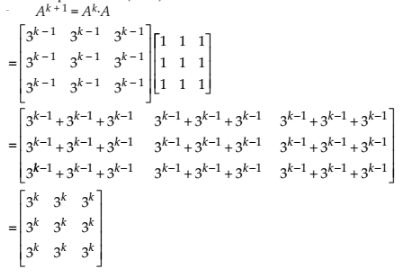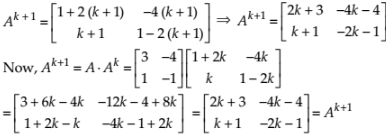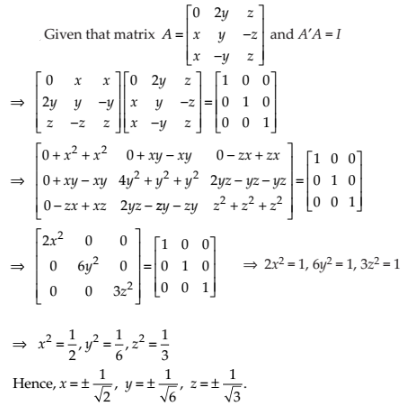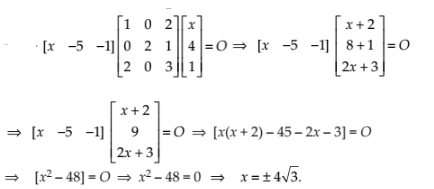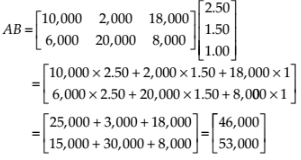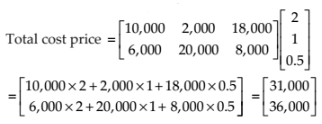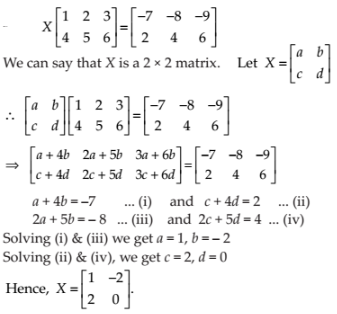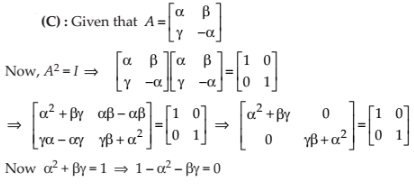NCERT Solutions for Class 12 Maths Matrices Miscellaneous Exercise
Hi Students, Welcome to Amans Maths Blogs (AMB). In this post, you will get the NCERT Solutions for Class 12 Maths Matrices Miscellaneous Exercise. This NCERT Solutions can be downloaded in PDF file. The downloading link is given at last.
NCERT Solutions for Class 12 Maths are not only the solutions of Maths exercise but it builds your foundation of other important subjects. Getting knowledge of depth concept of CBSE Class 12th Maths like Algebra, Calculus, Trigonometry, Coordinate Geometry help you to understand the concept of Physics and Physical Chemistry.
CBSE Class 12th is an important school class in your life as you take some serious decision about your career. And out of all subjects, Maths is an important and core subjects. So CBSE NCERT Solutions for Class 12th Maths is major role in your exam preparation as it has detailed chapter wise solutions for all exercise.
As we know that all the schools affiliated from CBSE follow the NCERT books for all subjects. You can check the CBSE NCERT Syllabus. Thus, NCERT Solutions helps the students to solve the exercise questions as given in NCERT Books.
NCERT Solutions for Class 12 Maths Matrices Miscellaneous Exercise
NCERT Solutions for Class 12 Maths Matrices Miscellaneous Exercise: Ques No 1.
Let 
NCERT Solutions:
To prove this, we use mathematical induction.
Given that p(n) : (aI + bA)n = anI + nan – 1bA.
At n = 1, we have p(1) : (aI + bA)1 = a1I + 1a1 – 1bA = al + bA
Now, at n = k, we let p(k) : (aI + bA)k = akI + kak – 1bA is true, …… (1)
Thus, we need to prove that at n = k + 1, p(k + 1) : (aI + bA)k + 1 = ak + 1I + (k + 1)ak + 1 – 1bA.
LHS = (aI + bA)k + 1
= (aI + bA)k(aI + bA)
= (akI + kak – 1bA)(aI + bA) (From (1))
= ak + 1I x I + kakbAI + akbAI + kak – 1b2A2
= ak + 1I + kakbA + akbA + kak – 1b2 x 0 (A2 = 0)
= ak + 1I + (k + 1)a(k + 1) – 1bA = RHS.
Hence, p(n) : (aI + bA)n = anI + nan – 1bA; it is also true at n = k + 1.
Therefore, p(n) : (aI + bA)n = anI + nan – 1bA is true for all values of n ∈ N.
NCERT Solutions for Class 12 Maths Matrices Miscellaneous Exercise: Ques No 2.
If
NCERT Solutions:
To prove this, we use mathematical induction.
Given that p(n) : 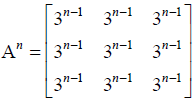
At n = 1, we have p(1) :
Now, at n = k, we let p(k) : 
Thus, we need to prove that at n = k + 1.
Therefore, by principle of mathematical induction, we get that 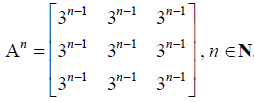
NCERT Solutions for Class 12 Maths Matrices Miscellaneous Exercise: Ques No 3.
If 

NCERT Solutions:
To prove this, we use mathematical induction.
Given that p(n) : 
At n = 1, we have p(1) : .
Now, at n = k, we let p(k) : is true, …… (1)
Thus, we need to prove that at n = k + 1.
Therefore, by principle of mathematical induction, we get that 
NCERT Solutions for Class 12 Maths Matrices Miscellaneous Exercise: Ques No 4.
If A and B are symmetric matrices, prove that AB – BA is a skew symmetric matrix.
NCERT Solutions:
Since A and B are symmetric matrices, A’ = A and B’ = B. To prove that (AB – BA) is skew symmetric matrix. It means, we need to prove (AB – BA)’ = -(AB – BA).
Now, LHS = (AB – BA)’ = (AB)’ – (BA)’ = B’A’ – A’B’ = BA – AB = -(AB – BA) = RHS.
Hence, (AB – BA) is skew symmetric matrix.
NCERT Solutions for Class 12 Maths Matrices Miscellaneous Exercise: Ques No 5.
Show that the matrix B′AB is symmetric or skew symmetric according as A is symmetric or skew symmetric.
NCERT Solutions:
Case I: Given that A is symmetric It means, A’ = A.
We need to prove that B’AB is symmetric. It means, we need to prove (B’AB)’ = B’AB.
LHS = (B’AB)’ = B’A'(B’)’ = B’A’B = B’AB = RHS.
Hence, B’AB is symmetric.
Case II: Given that A is skew-symmetric It means, A’ = -A.
We need to prove that B’AB is skew-symmetric. It means, we need to prove (B’AB)’ = -B’AB.
LHS = (B’AB)’ = B’A'(B’)’ = B’A’B = B'(-A)B = -B’AB = RHS.
Hence, B’AB is skew-symmetric.
NCERT Solutions for Class 12 Maths Matrices Miscellaneous Exercise: Ques No 6.
Find the values of x, y, z if the matrix 
NCERT Solutions:
NCERT Solutions for Class 12 Maths Matrices Miscellaneous Exercise: Ques No 7.
For what values of x : 
NCERT Solutions:
NCERT Solutions for Class 12 Maths Matrices Miscellaneous Exercise: Ques No 8.
If 
NCERT Solutions:
Given that 
Now,
Put these values in A2 – 5A + 7I, we get
LHS = = RHS
NCERT Solutions for Class 12 Maths Matrices Miscellaneous Exercise: Ques No 9.
Find x, if 
NCERT Solutions:
NCERT Solutions for Class 12 Maths Matrices Miscellaneous Exercise: Ques No 10.
A manufacturer produces three products x, y, z which he sells in two markets. Annual sales are indicated below.
(a) If unit sale prices of x, y and z are Rs 2.50, Rs 1.50 and Rs 1.00, respectively, find the total revenue in each market with the help of matrix algebra.
NCERT Solutions:
Let quantity matrix is .
And, unit selling price matrix is 
Now, total selling price matrix is
Thus, total revenue in Market 1 is Rs. 46000 and in Market 2 is Rs. 53000.
(b) If the unit costs of the above three commodities are Rs 2.00, Rs 1.00 and 50 paise respectively. Find the gross profit.
NCERT Solutions:
Let quantity matrix is .
Now, cost price matrix is
Thus,
Total cost price, CP = 31000 + 36000 = Rs. 67000.
Total selling price, SP = 46000 + 53000 = Rs. 99000.
Profit = SP – CP = 99000 – 67000 = Rs. 32000.
NCERT Solutions for Class 12 Maths Matrices Miscellaneous Exercise: Ques No 11.
A manufacturer produces three products x, y, z which he sells in two markets. Annual sales are indicated below.
NCERT Solutions:
NCERT Solutions for Class 12 Maths Matrices Miscellaneous Exercise: Ques No 12.
If A and B are square matrices of the same order such that AB = BA, then prove by induction that ABn = BnA. Further, prove that (AB)n = AnBn for all n ∈ N.
NCERT Solutions:
To prove this, we use mathematical induction.
Given that p(n) : ABn = BnA.
At n = 1, we have p(1) : AB = BA.
Now, at n = k, we let p(k) : ABk = BkA is true, …… (1)
Thus, we need to prove that at n = k + 1, p(k + 1) : ABk + 1 = Bk + 1A.
LHS = ABk + 1 = ABkB = (AB)Bk = (BA)Bk = Bk+1A = RHS
Hence, p(n) : ABn = BnA; it is also true at n = k + 1.
Therefore, p(n) : ABn = BnA is true for all values of n ∈ N.
Now, Again given that p(n) : (AB)n = AnBn.
At n = 1, we have p(1) : AB = BA.
Now, at n = k, we let p(k) : (AB)k = AkBk is true, …… (1)
Thus, we need to prove that at n = k + 1, p(k + 1) : (AB)k+1 = Ak+1Bk+1.
LHS = (AB)k + 1 = (AB)k(AB) = Ak(BkB)A = Ak(Bk+1)A = Ak(ABk+1) = Ak+1Bk+1 = RHS.
Hence, p(n) : (AB)n = AnBn; it is also true at n = k + 1.
Therefore, p(n) : (AB)n = AnBn is true for all values of n ∈ N.
NCERT Solutions for Class 12 Maths Matrices Miscellaneous Exercise: Ques No 13.
If 
(A) 1 + α² + βγ = 0
(B) 1 – α² + βγ = 0
(C) 1 – α² – βγ = 0
(D) 1 + α² – βγ = 0
NCERT Solutions:
NCERT Solutions for Class 12 Maths Matrices Miscellaneous Exercise: Ques No 14.
If the matrix A is both symmetric and skew symmetric, then
(A) A is a diagonal matrix
(B) A is a zero matrix
(C) A is a square matrix
(D) None of these
NCERT Solutions:
B.
Since A is symmetric and skew-symmetric both, we have A’ = A and A’ = -A.
Then, A = -A ⟹ 2A = 0 ⟹ A = 0 ⟹ A is a zero matrix.
NCERT Solutions for Class 12 Maths Matrices Miscellaneous Exercise: Ques No 15.
If A is square matrix such that A2 = A, then (I + A)³ – 7A is equal to
(A) A
(B) I – A
(C) I
(D) 3A
NCERT Solutions:
C.
Since A2 = A,
(I + A)³ – 7A
= I3 + A3 + 3IA(I + A) – 7A
= I + (A2)A + 3A(I + A) – 7A
= I + (A)A + 3A + 3A2 – 7A
= I + A2 + 3A2 – 4A
= I + 4A2 – 4A
= I + 4A – 4A = I



